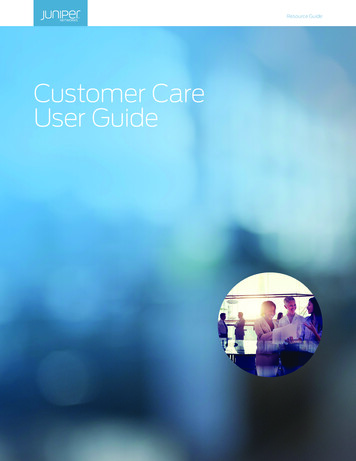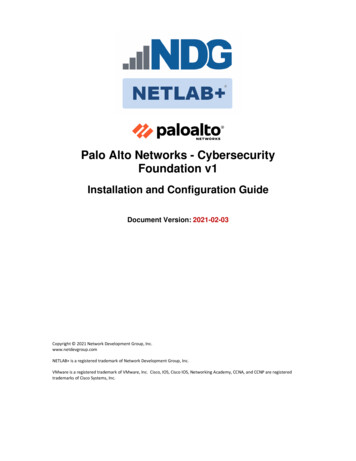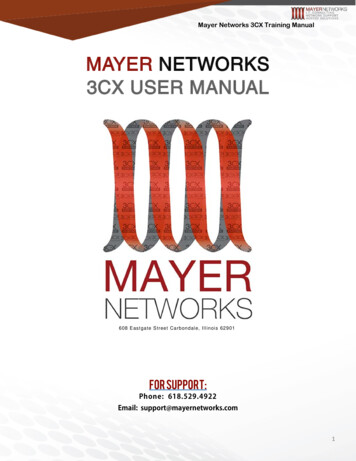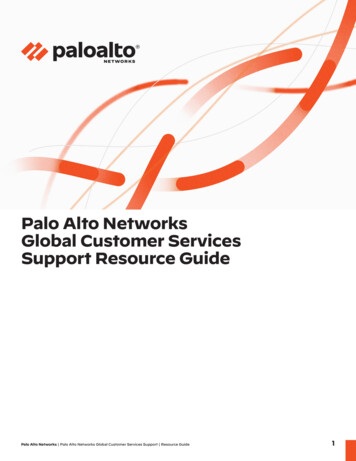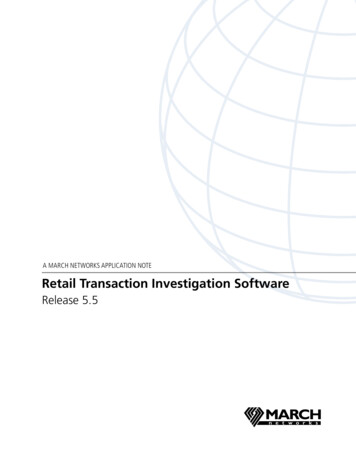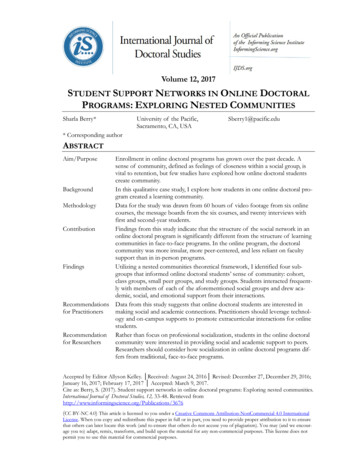
Transcription
Volume 12, 2017STUDENT SUPPORT NETWORKS IN ONLINE DOCTORALPROGRAMS: EXPLORING NESTED COMMUNITIESSharla Berry*University of the Pacific,Sacramento, CA, USASberry1@pacific.edu* Corresponding authorABSTRACTAim/PurposeEnrollment in online doctoral programs has grown over the past decade. Asense of community, defined as feelings of closeness within a social group, isvital to retention, but few studies have explored how online doctoral studentscreate community.BackgroundIn this qualitative case study, I explore how students in one online doctoral program created a learning community.MethodologyData for the study was drawn from 60 hours of video footage from six onlinecourses, the message boards from the six courses, and twenty interviews withfirst and second-year students.ContributionFindings from this study indicate that the structure of the social network in anonline doctoral program is significantly different from the structure of learningcommunities in face-to-face programs. In the online program, the doctoralcommunity was more insular, more peer-centered, and less reliant on facultysupport than in in-person programs.FindingsUtilizing a nested communities theoretical framework, I identified four subgroups that informed online doctoral students’ sense of community: cohort,class groups, small peer groups, and study groups. Students interacted frequently with members of each of the aforementioned social groups and drew academic, social, and emotional support from their interactions.Recommendations Data from this study suggests that online doctoral students are interested infor Practitionersmaking social and academic connections. Practitioners should leverage technology and on-campus supports to promote extracurricular interactions for onlinestudents.Recommendation Rather than focus on professional socialization, students in the online doctoralfor Researcherscommunity were interested in providing social and academic support to peers.Researchers should consider how socialization in online doctoral programs differs from traditional, face-to-face programs.Accepted by Editor Allyson Kelley. Received: August 24, 2016 Revised: December 27, December 29, 2016;January 16, 2017; February 17, 2017 Accepted: March 9, 2017.Cite as: Berry, S. (2017). Student support networks in online doctoral programs: Exploring nested communities.International Journal of Doctoral Studies, 12, 33-48. Retrieved 676(CC BY-NC 4.0) This article is licensed to you under a Creative Commons Attribution-NonCommercial 4.0 InternationalLicense. When you copy and redistribute this paper in full or in part, you need to provide proper attribution to it to ensurethat others can later locate this work (and to ensure that others do not accuse you of plagiarism). You may (and we encourage you to) adapt, remix, transform, and build upon the material for any non-commercial purposes. This license does notpermit you to use this material for commercial purposes.
Student Support Networks in Online Doctoral ProgramsImpact on SocietyFuture ResearchKeywordsAs universities increase online offerings, it is important to consider the issuesthat impact retention in online programs. By identifying the social structuresthat support online community, this study helps build knowledge around retention and engagement of online students.Future research should continue to explore the unique social networks thatsupport online students.community, online learning, virtual classrooms, cohort, social network, socializationINTRODUCTIONMany students enroll in doctoral programs expecting rigor and anticipating academic challenges.However, students often encounter unexpected social challenges in pursuit of the doctorate (Golde,2005). Numerous studies suggest that doctoral students struggle with isolation, disengagement, anxiety, and depression (Stubb, Pyhältö, & Lonka, 2011; Wyatt & Oswalt, 2013). Research suggests that asense of community can be a protective factor against isolation and disengagement (Drouin, 2008;Outzs, 2006; Rovai, 2002) and can help doctoral students manage feelings of anxiety and depressionin some cases (Stubb et al., 2011). A sense of community is defined as an overall feeling of membership, belonging, and trust within a supportive social group (McMillan & Chavis, 1986). In this qualitative case study, I explore how students in an online doctoral program define and create community.In a learning community, participants work together to pursue academic goals and provide social,emotional and scholarly support (Outzs, 2006; Yuan & Kim, 2014). Feelings of membership in alearning community have benefits for students (Ke & Hoadley, 2009). Socially, a sense of communityis associated with increased engagement in the learning environment (Rovai, 2003). Academically,community is associated with an increased likelihood of persistence (Tinto, 1993). Researchers suggest that creating community may be particularly difficult for doctoral students (Ali & Kohun, 2006;Lovitts, 2001). The independent nature of doctoral studies, the stress associated with rigorous academic programs, and competiveness over institutional and post-graduate resources may make it difficult for doctoral students to form bonds with peers and faculty (Anderson, Cutright & Anderson,2013). When students lack social connections with faculty and peers they are at risk of withdrawingfrom doctoral programs. In one of the largest studies on doctoral students’ experiences, Nettles andMillett (2006) determined that attrition ranged between 11% and 68% depending on the discipline.Students at every academic level derive benefits from membership within a learning community (Tinto, 1993). However, the ways in which students become members of a learning community varyacross contexts (Gardner, 2008). Many researchers have used a socialization framework to explorehow students develop the skills, dispositions, and experiences necessary for success during and afterthe academic program (Gardner, 2010; Weidman, Twale, & Stein, 2001). Researchers assert that doctoral socialization processes, including mentoring and advising relationships, participation in researchand lab groups and conference attendance impact students’ academic, professional and social adjustment to the doctoral program (Gardner, 2010; Lovitts, 2001). Doctoral students who have success inthe socialization process and are able to form positive and productive relationships with faculty andpeers are likely to feel a sense of membership within an academic community (Lovitts, 2001).Students’ experiences of socialization into a learning community vary based on disciplinary, institutional, and environmental contexts (Gardner, 2008). For example, Golde (2005) and Gardner (2008)have noted that socialization in the sciences occurs in lab groups, whereas socialization in the humanities occurs through independent work and advisor-advisee relationships. Weidman et al. (2001) notedthat doctoral socialization is also impacted by departmental culture and interactions with faculty andpeers within the academic department. Doctoral students who have supportive interactions with faculty and who are encouraged in their scholarly pursuits are more likely to feel integrated into the department than students who lack such interactions (Bagaka’s, Badillo, Bransteter, & Rispinto, 2015;Lovitts, 2001).34
BerryWhile it is widely held that socialization into learning communities is contextual (Gardner, 2008), fewstudies have explored the ways in which online doctoral students become members of virtual learning communities (Rovai, 2003). Online students face unique barriers in making connections withpeers (Ke & Hoadley, 2009), including challenges associated with creating relationships at a distance.As a result, online students may be at high risk of attrition from academic programs (Rovai, 2003).Given the centrality of community to doctoral students’ engagement and persistence in traditionalprograms (Jairam & Kahl, 2012), and the dearth of research on community in online doctoral contexts, it is important for researchers and practitioners to understand the sources of social support forthis unique population. By understanding the ways in which online students create community and byidentifying the sources of support for connection in online doctoral programs, researchers and practitioners can design programs that support distance learners’ satisfaction, persistence, and retention.LITERATURE REVIEWResearchers and practitioners have devoted considerable effort and scholarship to undergraduatestudents’ experiences in learning communities but have overlooked the needs of graduate students(Patton & Harper, 2003). White and Nonnamaker (2008) suggest that the dearth of literature ondoctoral communities is associated with beliefs about the capacity of those students to quickly adaptto academic environments and beliefs that students who are successful enough to gain entry intodoctoral programs do not need support with social integration into academic programs. Despite thedearth of literature, a few studies have explored doctoral students’ communities.Strong relationships with advisors are central to doctoral students’ feelings of connection and likelihood of persistence (Bagaka’s et al., 2001; Lovitts, 2001). Advisors play multiple, critical roles indoctoral students’ experiences (Anderson et al., 2013). Advisors provide doctoral students withmentorship and professional development (Gardner, 2008). Additionally, advisors can help connectstudents to resources at the department and institution and help students foster professional andpersonal networks that can provide a range of academic, social, and emotional support to students(Earl-Novell, 2006).Anderson et al. (2013) found that productivity, satisfaction, and degree progress are all impacted bydoctoral students’ connections with faculty in the academic department. Students who lacked strongrelationships within their department were likely to have reduced academic productivity and a weakersense of community than more highly connected students. Ali and Kohun (2006, 2007) found thatdoctoral students who experienced challenges with their advisors were more likely to withdraw fromacademic community. They suggest that doctoral programs should provide opportunities for peers tocreate social relations with faculty, staff, and peers, as these relationships provide social support. Toward that end, they recommend the creation of activities that promote student-peer and studentfaculty interaction, including orientations, brown bag lunches, and research colloquia. These experiences provide opportunities for academic and professional development and socialization into departmental and academic cultures (Ali & Kohun, 2006, 2007; Lovitts, 2001).In addition to focusing on the academic benefits such as retention and productivity (Ali & Kohun,2006, 2007), researchers have explored the impact of community on doctoral students’ social andemotional wellbeing. In a survey of nearly 700 PhD students, Stubb et al. (2011) found that a senseof community can act as a buffer against feelings of stress, anxiety, isolation, and burnout. Drawingon that same data, Pyhältö, Stubb, and Lonka (2009) found that feelings of membership in a community can be a source of empowerment for emotionally overwhelmed students and can help themmanage stress and exhaustion. Stubb et al. (2011) and Pyhältö et al. (2009) found that doctoral students who felt they were in a community received psychological benefits from their membership,including encouragement, inspiration, academic assistance, and emotional support.Interactions with faculty and connections with peers provide doctoral students with a sense of support in academic program. However, the ways in which students interact with faculty and peers is35
Student Support Networks in Online Doctoral Programscontextual and depends on a range of factors including institutional and departmental cultures andindividual characteristics (Ali & Kohun, 2007). White and Nonnamaker (2008) explored the ways inwhich doctoral students’ membership within different subcommunities provided a sense of support.In a two-year study of 60 doctoral students, they found that doctoral students in the sciences received support from their relationships in five different groups: their discipline, institution, department, lab, and advisor. The support doctoral students experienced in various subgroups impactedtheir overall experiences (White & Nonnamaker, 2008).Other researchers have explored social support networks outside of class. Jairam and Kahl (2012)studied the impact of academic friends, family, and faculty on doctoral students’ stress. They foundthat doctoral students benefit from connections with all three groups, and these groups act as socialsupport systems when they provide acceptance, assistance, and advice and fulfill basic social needs.Jairam and Kahl (2012) further found that encouragement, professional advice, and material supporthelped mitigate feelings of stress and isolation within a doctoral program.Researchers have also explored the ways in which doctoral students from marginalized groups develop support networks within and outside of the academic program. Patton (2009) looked at the waysin which Black women in graduate programs seek out mentors to provide psychosocial support andassistance with academic tasks such as opportunities for research and publication. Patton (2009)notes that Black masters and doctoral students may seek out mentors in the academy, including faculty outside of their department. They may also look for social support outside of the academy, drawing on mentors from other fields and from their communities to find support for a range of interpersonal and professional needs.C OMMUNITY IN ONLINE DOCTORAL P ROGRAMSDespite the growing body of literature on doctoral students’ communities, little attention has beengiven to doctoral students’ experiences in online contexts. Literature on undergraduate and master’sstudents in online programs suggest that online students receive academic, social, and emotionalbenefits from feelings of membership in a learning community, but face many contextual barriers inconstructing community (Lear, Ansorge, & Steckelberg, 2010; Whiting, Liu, & Rovai, 2008). Vesely,Bloom, and Sherlock (2007) noted that both online students and faculty said that it was more difficultto connect online than in a traditional class and that online connection required more effort insideand outside of the classroom.Instructors play a key role in the online experience (Garrison, 2011). Instructors can use a variety ofpedagogical strategies to promote interactivity in online learning environments (Lear et al., 2010;McElrath & McDowell, 2008). The ways in which instructors facilitate discussions and develop assignments can promote peer interaction and strengthen online students’ sense of community (McInnerney & Roberts, 2004). Despite a growing base of literature on best practices in online teaching,instructors may not always encourage the peer interactions necessary for online students to develop acommunity. In a study of 535 online graduate students, Bianchi-Laubusch (2016) found that 42% ofstudents in an asynchronous program never had the opportunity to communicate with peers. Haythornthwaite, Kazmer, Robins, and Shoemaker (2006) note that it is easy for online students to “fadeto the back row” of online classes and not participate. Instructors must be intentional about helpingstudents engage with peers in online classrooms, or else it is unlikely to happen (Palloff & Pratt,1999; Stepich & Ertmer, 2003).Positive interactions with instructors and satisfaction with curriculum have been associated withonline students’ sense of community (Rovai, 2003; Tu & McIssac, 2002). Dawson (2006) found thatonline students who have more frequent interactions with peers and instructors typically developstronger feelings of community than peers who have infrequent social interactions. A number ofactivities inside the classroom have been found to impact online students’ sense of community(Rovai, 2003). Whole group discussions that center on students’ professional and personal goals haveincreased students’ feelings of connection and engagement to the online group (Garrison, 2011).36
BerryCollaboration is also essential in fostering community in online programs (Baab, 2004; Stepich &Ertmer, 2003). Wang and Morgan (2008) found that instant messaging within an online class encouraged collaborative learning and helped online students create bonds. Small group projects and collaborative learning activities have also enhanced feelings of connection among online students (Liu,Magjuka, Bonk, & Lee, 2007; Rovai, 2002).Outside of the classroom, online students may be at a disadvantage with regard to social interaction(Brown, 2001). Cleveland-Innes and Gauvereau (2011) and Conrad (2005) have pointed out thatonline students lack spaces for informal interaction, such as hallways and cafeterias, making it harderfor online students to connect. Additionally, student support services that facilitate peer-interactionon campus are not typically extended to online students (Kretovics, 2003). As a result, online students may struggle with developing feelings of connection to an academic community (Rovai, 2003).Researchers know that feelings of membership in a learning community have academic, social, andemotional benefits for online students (Pallof & Pratt, 1999; Rovai, 2003). While researchers knowthat community matters, they have not explored how online doctoral students construct community.This study begins to fill that gap in the literature.THEORETICAL FRAMEWORKThe theoretical framework for this study is based on conceptual frames from McMillan and Chavis’(1986) definition of community, Rovai’s (2003) research on online community, and White andNonnamaker’s (2008) doctoral student community of influence model. McMillan and Chavis (1986)assert that in a community participants will have feelings of belonging, membership, trust, and mutual support. These feelings will be developed through frequent, positive interaction and the exchangeof information and resources. Rovai (2003) suggests that in an online program students will becomeintegrated into a learning community through their interactions in online classrooms. White andNonnamaker’s (2008) doctoral student community of influence model further parses out the spacesand relationships where doctoral students might develop a sense of community. Drawing on thework of Golde (2005), Jones and McEwen (2000), and Tinto (1993), White and Nonnamaker (2008)argue that, for doctoral students, academic community can be understood as occurring in five overlapping spheres ---the discipline or professional field, the institution, the department, the lab, and theadvisor-student relationship. While many other spheres impact doctoral students’ experiences, theirsense of community is based significantly on where they are in relationship to any of the aforementioned groups. Researchers have yet to explore how online doctoral students’ sense of community isimpacted by their participation in these or other nested groups. Due to its’ detail and clarity, Whiteand Nonnamaker’s (2008) conceptual framework serves as an appropriate theoretical starting pointfor exploring online doctoral students’ experiences.METHODSR ESEARCH QUESTIONThis study was driven by the research question, “What spheres, networks, and relationships impactstudents’ sense of community in an online doctoral program?”SETTING FOR THE STUDYThis study was conducted in an online Doctorate in Education program at the University of theWest (a pseudonym). The program was a three-year interdisciplinary program focused on educationleadership. There were approximately 160 students in the program. Students met synchronously twiceweekly in virtual classrooms.37
Student Support Networks in Online Doctoral ProgramsT HE C ASE STUDYTo explore online doctoral students’ sense of community, I used qualitative methods. Qualitativemethods allow for researchers to prioritize participants’ perspectives in data collection and analysis(Merriam, 2014). Using participants’ perspectives is critical with a topic like online community, whereexperiences are highly subjective and contextual (Black, Dawson, & Priem, 2008). Students’ experiences may vary widely, and using qualitative methods can help researchers capture a broad range ofexperiences and relate those experiences in ways that capture details, nuances, and variability (Merriam, 2014)I used case study methods to explore community in an online doctoral program. In conducting a casestudy, researchers can use multiple sources of data to explore a phenomenon (Merriam, 2014). Inusing multiple sources, researchers can triangulate findings, thereby enhancing their validity (Merriam,2014). This study drew on data from digital video archives of the class sessions, threads from theclassroom message boards, and interviews with first and second-year students in the online program.DATA C OLLECTIONDigital video archivesTo learn about the interactions and experiences that potentially impacted the learning community, Iwatched archived video footage of virtual classroom sessions. I reviewed recordings from three firstyear and three second-year courses over two semesters, totaling approximately 60 hours. I selectedclasses taught by new and senior faculty to get a range of experiences.To collect data from the video footage, I used a semi-structured observation protocol. In the firsthalf of the protocol, I made notes about everything that was observed in the classroom space, divided into five-minute increments. In the second half of the protocol, I identified examples of community in the classroom. Drawing on McMillan and Chavis’ (1986) definition of community, I notedexamples of support, trust, membership, and belonging. I also noted any references to other spheresof community as outlined in White and Nonnamaker’s (2008) doctoral student community of inquiryframework. Specifically, I noted references to the discipline, sub-discipline, or professional field, theinstitution, the department, the lab, and the advisor-student relationship (White & Nonnamaker,2008). In addition to identifying elements of community as defined by the literature, I also used theprotocol to make note of interactions that did not fit with the literature on community, as well asdisconfirming cases.Message boardsIn the online program at University of the West, each online course had a message board. I observedvideo footage from six courses and also analyzed the six message boards associated with those courses. Students were required to utilize the boards, and faculty and staff occasionally utilized them. Analyzing message boards helped me gain another perspective on how online doctoral students’ constructed community.InterviewsTo ensure that my interpretations about community were reflective of students’ experiences, I conducted twenty semi-structured 45-minute interviews. Interviews allowed me to understand how students defined community and explore where they experienced community. Interviews also allowedme to validate my assertions and explore alternate hypotheses.Dawson (2006) and Rovai (2003) both found that students who participate more frequently in onlineclasses have a greater sense of community. For that reason, I solicited interview participants whowere the most and least frequent participants in the online courses. I used a semi-structured protocolto interview the students. In the interviews I asked about how students’ defined community and38
Berryabout the interactions that impacted their sense of community, including interactions within theirdepartment, with peers, and with other individuals at the institution. Some questions were openended, in order to allow students to share any unique or disconfirming experiences. After interviewing ten students from the first cohort and ten students from the second cohort, theoretical saturationwas reached.DATA ANALYSISData collection produced transcripts from six message boards and twenty interviews, as well as observation protocols from 60 hours of footage. To analyze these texts, I conducted a thematic contentanalysis (Saldaña, 2012). I began the analysis with a set of codes drawn from definitions of community from the literature (McMillan & Chavis, 1986) and spheres of support drawn from White andNonnamaker’s (2008) doctoral student community of inquiry framework. Specifically, I highlightedindicators of community, such as membership, belonging, support, and trust, and noted spheres ofcommunity, such as the classroom and the research group. Utilizing Nvivo, a qualitative data analysissoftware system, I conducted two cycles of coding. First I coded everything that fit with the predetermined codes from the coding scheme (Saldaña, 2012). The coding scheme was amended to reflect the emerging patterns, and codes that did not apply were removed from the data. For example,many new codes emerged that were relevant to the learning management system, including references to the virtual classroom. Codes also emerged related to types of communication (i.e., texting,instant messaging) and to types of social media (i.e., Facebook). In the second cycle of coding I reanalyzed the data using the established and emergent codes (Saldaña, 2012). To develop the casestudy, I identified the key themes related to how and where students constructed community andtriangulating these themes across data sources (Merriam, 2014). Themes that held across datasources, and particularly themes that were supported via member checks in interviews with students,became the final case study.FINDINGSIn the online doctoral program at the University of the West, students defined their community as ahighly interactive and supportive social group where peers collaborated to pursue degree-relatedgoals. Students also shared professional advice and provided emotional support to help manage personal challenges associated with pursuing a doctorate. While all students had unique descriptions ofcommunity, each of the twenty interviews revealed that online doctoral students derived feelings ofmembership from interactions in four groups --the cohort, their classrooms, small study groups, andsmall friendship groups. Brief descriptions of each subgroup are included in Table 1. In the paragraphs that follow I describe the role of each group in shaping online doctoral students’ sense ofcommunity.C OHORT R ELATIONSHIPSThe doctoral program at the University of the West utilized a cohort model. At the time of the study,there were two cohorts of approximately 60 students each. In interviews, students suggested that thecohort was their largest social sphere of influence within the program. The cohorts were selfcontained groups, and students had virtually no interaction with students outside of their cohort.Within the boundaries of this pre-assigned 60-person group students developed feelings of connection and closeness.39
Student Support Networks in Online Doctoral ProgramsTable 1. Subcommunities in the Online Doctoral ProgramSubcommunities in theOnline Doctoral ProgramDescriptionRelationship to Online DoctoralStudents’ Sense of communityCohortUpon entry into the program,students were placed into a60-person cohort.Cohort membership provided students with a sense of collectiveidentity.ClassroomClasses were 9-15 studentseach. Many students wereintentional about taking classes with the same group eachsemester. These peer groupsgrew closer over time.Classes provided spaces for smallgroups of students to learn abouteach other. Students provided academic support (e.g., sharing resources, reviewing papers) to classmates.Friend GroupsAll students interviewed hadat least three to five friends inthe program with whom theyspoke to at least once weekly.Students provided social support tosmall groups of friends by sendingencouraging messages to each other.Study GroupsAll students interviewedworked on assignments withat least one other peer. Virtualand in-person study groupsranged from two to sevenmembers.Students provided in-depth academic support to colleagues via studygroups. Students would read andedit papers and would work collaboratively for two to eight hours perweek in study sessions.Students suggested that the cohort was an important group for students because it added structureand cohesion to the online experience. The cohort was an exclusive group, comprised of studentswho began the program at the same time and were expected to graduate together. Students in thesame cohort followed the same academic timeline, which included taking all of their core coursestogether. The structure of the program gave a students’ a sense of cohesiveness that transformed thecohort into a close-knit social group. For Kayla, being a part of a cohort of students who took thesame classes together helped bring students closer by creating a shared experience.I think it is very important. We are cohort 1 and I know that I have other classmates thatmake a great deal of the fact that we are the first cohort. The biggest impact that the cohorthas on community is that we are taking the same courses. So again, just going back to thatshared experience no matter when you have your methods class we all are taking a methods class at the same point, so we are all taking about the same terminology and the samereadings. That part has been helpful.Many students echoed Kayla’s perspective that the cohort model led to a shared experience, wherestudents were taking the same classes, having the same academic experiences, and developing acommon language. Even though students may not have had the same instructor, the cohort modelcombined with sequential classes meant that peers i
demic programs, and competiveness over institutional and post-graduate resources may make it diffi-cult for doctoral students to form bonds with peers and faculty (Anderson, Cutright & Anderson, 2013). When students lack social connections with faculty and peers they are at risk of withdrawing from doctoral programs.


